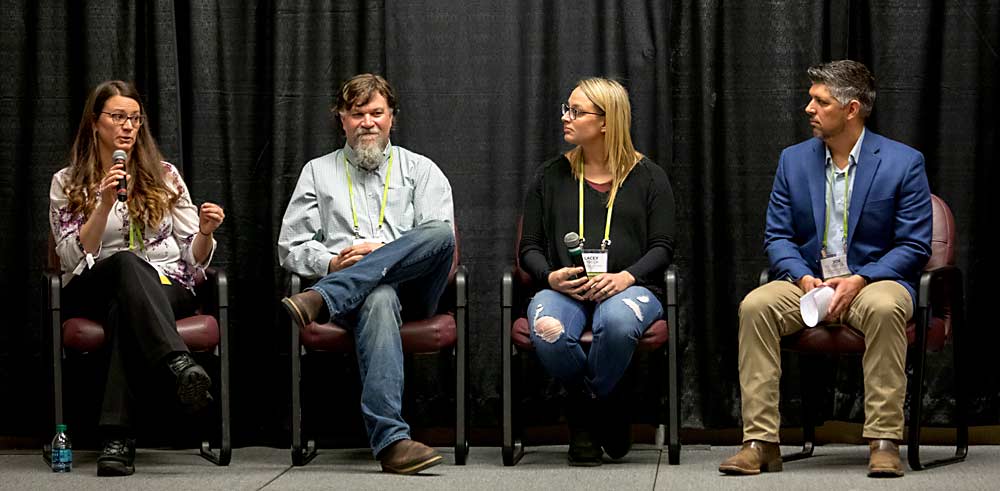
From left, Sadie Drury, Bill Dickard, Lacey Lybeck and Joe Cotta speak about vineyard labor challenges and solutions during the 2019 Washington Winegrowers Association convention and trade show on Wednesday, February 13, at the Three Rivers Convention Center in Kennewick, Washington. (TJ Mullinax/Good Fruit Grower)
Labor remains the biggest cost for wine grape growers in Washington, and for many, it remains the biggest concern heading into each new season.
Several vineyard managers shared their experiences with managing labor woes and improving efficiencies in the vineyard during day two of the Washington Winegrowers annual conference Wednesday.
North Slope Vineyards is focused on keeping workers happy and getting by with fewer crews, general manager Sadie Drury said — and mechanizing where possible to help get by with less labor. Each year, they buy more electric pruners, and between pre-pruner and electric pruners, they’ve seen a 40-percent reduction in pruning labor costs.
The company also uses licensed farm labor contractors for big jobs, but otherwise has taken steps to keep its 40 employees happy, offering benefits, paying a competitive starting wage, budgeting for holidays, bonuses and paid days off and making employees feel valued and engaged with weekly viticulture education meetings.
Bill Dickard, vineyard manager for Shaw Vineyards, has found labor savings by mechanizing a number of vineyard tasks:
—For shoot thinning, labor went from 17.1 hours per acre by hand to 2.9 hours per acre mechanically.
—Leaf removal, where there’s potential to see huge savings, he said, showed a decrease to 1.3 hours per acre mechanically, versus 25.1 hours per acre by hand.
—Previously, the company used pull-type harvesters, but shifted last year to two over-the-row harvesters, reducing the size of the harvest crew from about 20 to between seven and 10. Manhours fell from 41.3 hours per acre for hand harvesting, to 6.9 hours with the old technology, to 2.8 hours for the new equipment.
An afternoon session of the conference focused on pests and diseases. Washington State University professor of entomology Doug Walsh shared some bad news about grape mealybugs: A single infected crawler per vine infected 10 percent of vines with grapevine leafroller disease in assays; in a second batch, 20 percent got infected.
“From an IPM practitioner standpoint, this is really bad news. This effectively makes the threshold for mealybugs zero,” Walsh said. “We would like to have some threshold where you wouldn’t have to spray, but the take-home message here is ‘one kiss is all it takes.’”
Naidu Rayapati, director of WSU’s Irrigated Agriculture Research and Extension Center in Prosser, reminded growers of the three viruses for which roguing, or removing vines, might be a good option for control — leafroll, red blotch and fanleaf.
Roguing may be more effective in blocks with low rates of spread compared with high rates of spread, when vineyard replacement may be more effective, he said.
Growers should flag symptomatic vines in the fall, then test samples (fall for leaf samples, winter for cane samples) and remove virus-positive vines and replant with clean, virus-tested cuttings or young vines.
—by Shannon Dininny






Leave A Comment